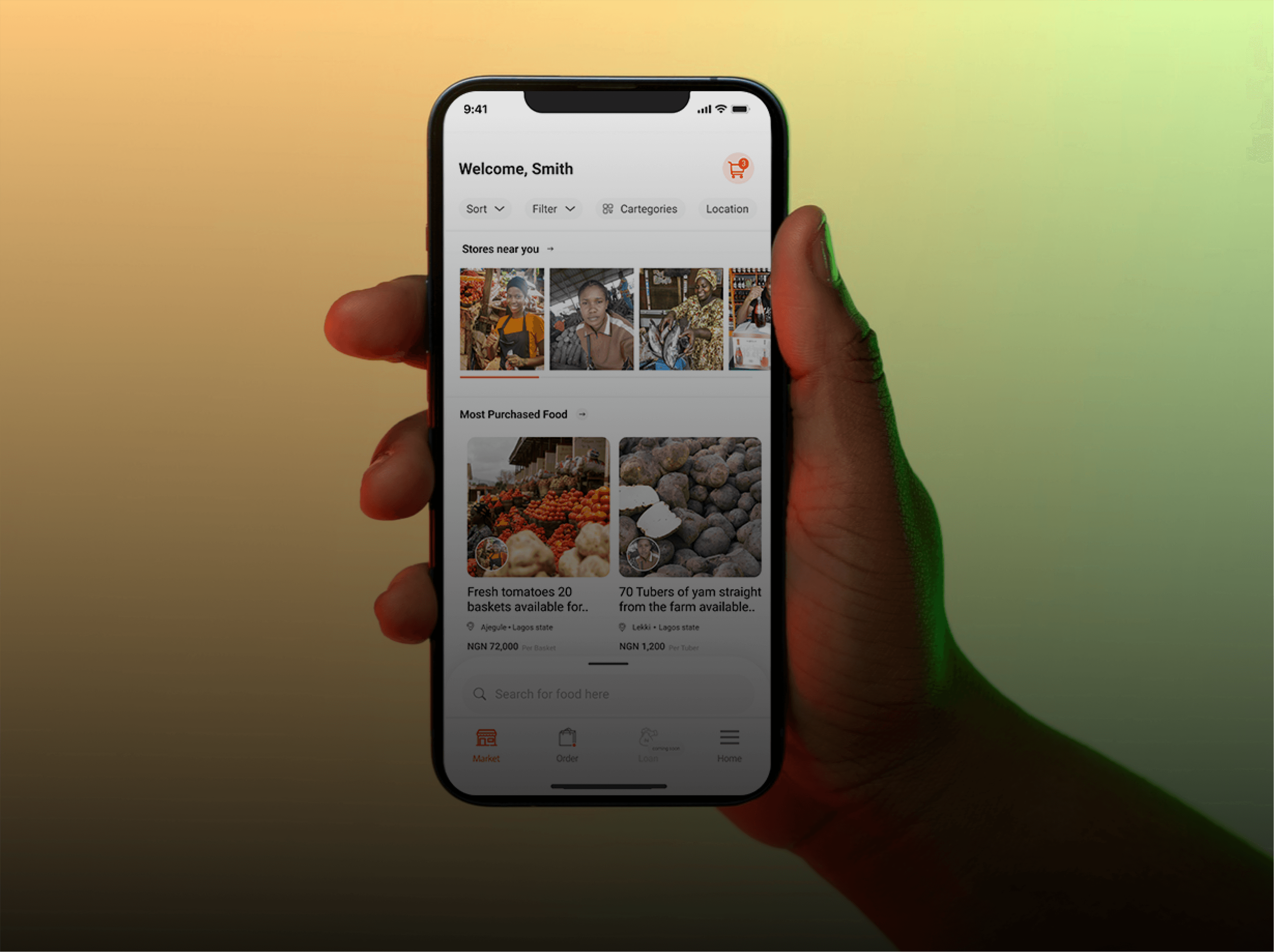

A scalable system that enables local food sellers to reach more customers using an e-commerce model.
A scalable system that enables local food sellers to reach more customers using an e-commerce model.
A scalable system that enables local food sellers to reach more customers using an e-commerce model.
Easyfood aims to create a scalable system that enables local food sellers to reach more customers using an e-commerce model. Our team, consisting of a product manager, designers, and developers, worked tirelessly for months to build this.
Easyfood aims to create a scalable system that enables local food sellers to reach more customers using an e-commerce model. Our team, consisting of a product manager, designers, and developers, worked tirelessly for months to build this.
Easyfood aims to create a scalable system that enables local food sellers to reach more customers using an e-commerce model. Our team, consisting of a product manager, designers, and developers, worked tirelessly for months to build this.
Duration
Duration
6 weeks (2022)
6 weeks (2022)
DELIVERABLES
DELIVERABLES
UI Screens, Design system
Product document, UX Artifacts
UI Screens, design system, product document, UX Artifacts
UI Screens, Design system
Product document, UX Artifacts
Scope
Scope
Documentation, Research
Strategy, Prototype & testing
Documentation, Research, Strategy,
Prototype & testing
Documentation, Research
Strategy, Prototype & testing
Role
Role
UI/UX designer
Product, UX designer, Product Strategy,
UX Writer,
UI/UX designer
System Overview
System Overview
System Overview
In Nigeria, the food supply chain is largely physical, inefficient, and time-consuming. Purchase of food items such as grains, livestock, or tuber is traditionally done at local markets, a process that requires a lot of time, money, and effort.
Foodstuff sellers make sales primarily from their shops on the street or at local markets, with no means for buyers to purchase or place orders remotely.
To better understand the needs and frustrations of both buyers and sellers within the food supply chain in Nigeria, we conducted user research through interviews and surveys.
Based on our findings, we developed various UX articfacts such as personas, user journey maps, user flows etc. to guide the design and development of Easyfood.
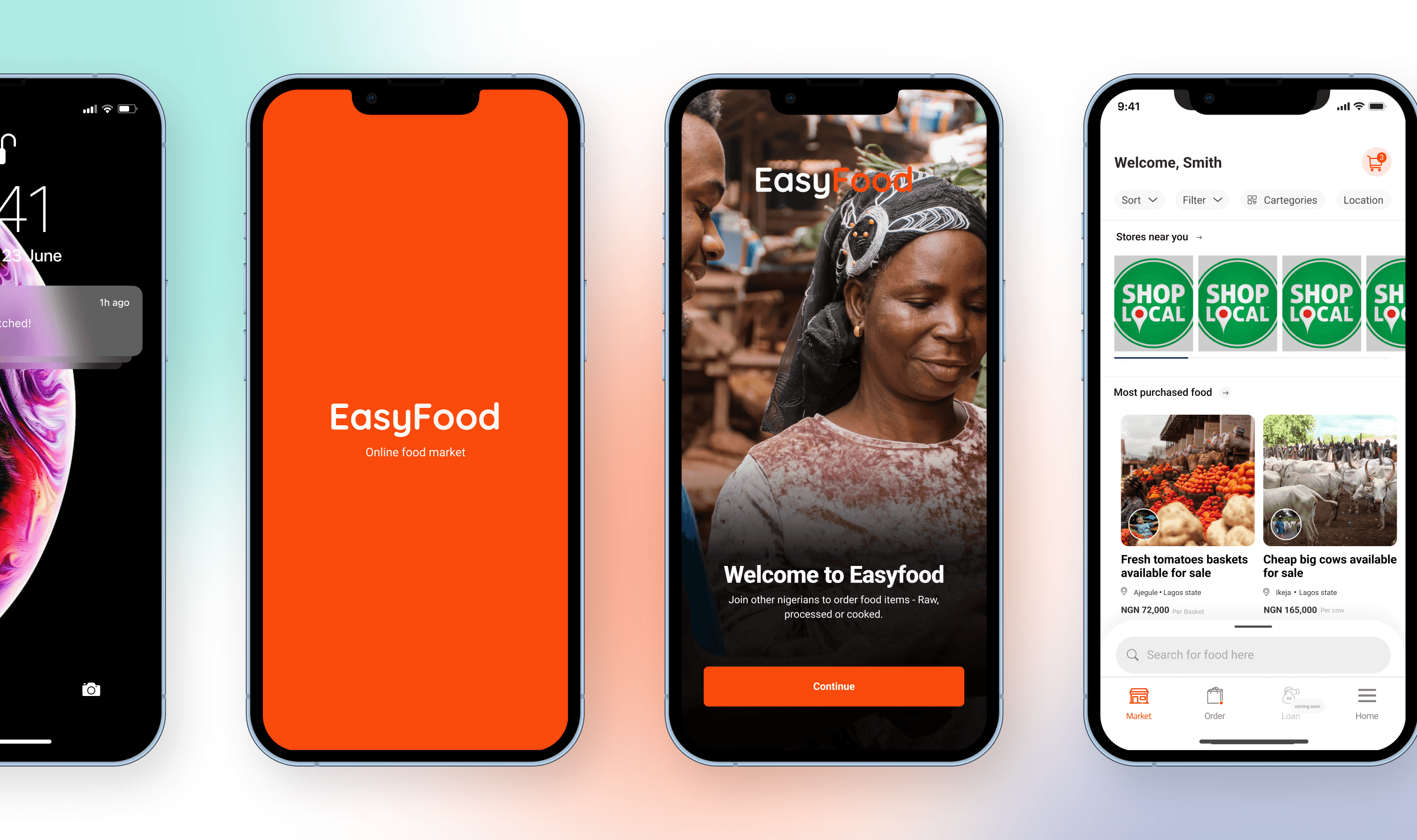


Connecting local food vendors to a -
Connecting local food vendors to a -
Combining sophisticated design with effortless
larger market
larger market
larger market
Project Goal
Project Goal
The goal of the project is to create a scalable system that enables local food sellers in Nigeria to reach more customers using an e-commerce model.
The project scope included the development of a mobile application for buyers and sellers, an admin dashboard for the back office, and a design system for the entire platform.
The project duration was 2 months for research and design and an additional period with the development team.
The target audience for the platform included buyers looking for a convenient way to purchase food items and sellers looking to expand their customer base and manage their sales remotely.
The project followed the design thinking process, including user research, ideation, prototyping, testing, and implementation.
The goal of the project is to create a scalable system that enables local food sellers in Nigeria to reach more customers using an e-commerce model.
The project scope included the development of a mobile application for buyers and sellers, an admin dashboard for the back office, and a design system for the entire platform.
The project duration was 2 months for research and design and an additional period with the development team.
The target audience for the platform included buyers looking for a convenient way to purchase food items and sellers looking to expand their customer base and manage their sales remotely.
The project followed the design thinking process, including user research, ideation, prototyping, testing, and implementation.
Problem Statement
Problem Statement
Problem Statement
Easyfood aims to solve the inefficient and time-consuming process of buying and selling food items in Nigeria. Currently, food purchases and sales are primarily done through physical means, such as local markets and street shops.
This process requires a lot of time, money, and effort for buyers, and sellers are limited in their reach and ability to sell remotely.
We aim to address this problem by providing a scalable and efficient e-commerce platform that enables local food sellers to reach more customers and allows buyers to easily purchase food items online.
The platform will offer a wide variety of products, including grains, livestock, and tuber, as well as local and organic options and deals and discounts. It will also provide multiple delivery options, including home delivery and pickup at a local store, to meet the needs of its users.
By providing an end-to-end solution for buying and selling food items online, Easyfood aims to make the process more convenient and cost-effective for both buyers and sellers in Nigeria.
Easyfood aims to solve the inefficient and time-consuming process of buying and selling food items in Nigeria. Currently, food purchases and sales are primarily done through physical means, such as local markets and street shops.
This process requires a lot of time, money, and effort for buyers, and sellers are limited in their reach and ability to sell remotely.
We aim to address this problem by providing a scalable and efficient e-commerce platform that enables local food sellers to reach more customers and allows buyers to easily purchase food items online.
The platform will offer a wide variety of products, including grains, livestock, and tuber, as well as local and organic options and deals and discounts. It will also provide multiple delivery options, including home delivery and pickup at a local store, to meet the needs of its users.
By providing an end-to-end solution for buying and selling food items online, Easyfood aims to make the process more convenient and cost-effective for both buyers and sellers in Nigeria.
Design thinking process
Design thinking process
Design thinking process
Empathize: Our first step was to understand the needs and frustrations of both buyers and sellers within the food supply chain in Nigeria. We conducted user interviews and surveys to gather insights into their experiences with the current process of buying and selling food items.
Define: Based on our research, we identified the main problems faced by both buyers and sellers. For buyers, the process of purchasing food items was time-consuming and required a lot of effort and resources. For sellers, their sales were primarily limited to their physical locations, with no means for remote sales.
Ideate: Using our user personas and user stories as a guide, we brainstormed and prototyped potential solutions to the identified problems. We focused on creating an end-to-end solution that would enable buyers to easily purchase food items online and sellers to reach a wider audience.
Prototype: We created wireframes and prototypes of the Easyfood platform, including the mobile application and seller dashboard. We tested these prototypes with a small group of individuals from our target user groups to gather feedback and make any necessary adjustments.
Test: We conducted user testing with a small group of individuals from our target user groups to gather feedback on the design and functionality of the Easyfood platform. Based on this feedback, we made any necessary adjustments to the design.
Implement: Based on the feedback from user testing, we finalized the design of Easyfood and prepared it for development.
Empathize: Our first step was to understand the needs and frustrations of both buyers and sellers within the food supply chain in Nigeria. We conducted user interviews and surveys to gather insights into their experiences with the current process of buying and selling food items.
Define: Based on our research, we identified the main problems faced by both buyers and sellers. For buyers, the process of purchasing food items was time-consuming and required a lot of effort and resources. For sellers, their sales were primarily limited to their physical locations, with no means for remote sales.
Ideate: Using our user personas and user stories as a guide, we brainstormed and prototyped potential solutions to the identified problems. We focused on creating an end-to-end solution that would enable buyers to easily purchase food items online and sellers to reach a wider audience.
Prototype: We created wireframes and prototypes of the Easyfood platform, including the mobile application and seller dashboard. We tested these prototypes with a small group of individuals from our target user groups to gather feedback and make any necessary adjustments.
Test: We conducted user testing with a small group of individuals from our target user groups to gather feedback on the design and functionality of the Easyfood platform. Based on this feedback, we made any necessary adjustments to the design.
Implement: Based on the feedback from user testing, we finalized the design of Easyfood and prepared it for development.
User Archetypes
User Archetypes
User Archetypes
We created fictional characters that represent a specific type of user with shared characteristics, goals, and pain points. To provide additional insight into user motivations and behaviour
It's important to note that these user archetypes are not meant to be exhaustive or represent all users, but rather provide a useful starting point for us to understand user needs.
The Busy Professional:
Demographics: This user is likely to be a working adult, possibly with a family, who is busy with work and other responsibilities. They may have a higher income and be willing to pay a premium for convenience.
Psychographics: This user values their time and is looking for ways to streamline their grocery shopping process. They may be interested in healthy eating, but may not have the time or energy to devote to meal planning and shopping.
End Goals: This user is looking for a quick and easy way to purchase food items online and have them delivered to their home or office. They want to be able to browse and select products with minimal effort and have the option to schedule recurring deliveries.
Frustrations: This user may be frustrated with the time and effort required to shop for groceries in person, as well as the limited selection and higher prices at local stores. They may also be frustrated with the inconvenience and hassle of scheduling delivery or pickup times that fit their schedule.
The Budget-Conscious Shopper:
Demographics: These shoppers are likely to be concerned with saving money on their grocery bills and may be more price-sensitive than other users. They may be on a fixed income or have a limited budget for groceries.
Psychographics: Budget shoppers value and a looking for ways to stretch their grocery budget. They may be willing to shop around to find the three best deals and may be open to trying new or generic brands to save money.
End Goals: Budget-conscious shoppers are looking for a platform that offers competitive prices and discounts on food items. They want to be able to easily compare prices and find the best deals to save money.
Frustrations: Shoppers may be frustrated with the high prices at local stores or markets and the lack of discounts or deals. They may also be frustrated with the time and effort required to compare prices and find the best deals.
4. The Rural Consumer:
Demographics: A rural consumer is likely to live in a rural area with limited access to local markets or grocery stores. They may have a lower income and be more price-sensitive.
Psychographics: A rural consumer values convenience and accessibility and is looking for a way to purchase food items remotely. They may be open to trying new products, but may also be concerned with finding the best deals to save money.
End Goals: A rural consumer is looking for a platform that allows them to purchase food items online and have them delivered to their remote location. They want to be able to easily browse and compare different products and make informed purchasing decisions.
Frustrations: A rural consumer may be frustrated with the limited selection and higher prices at local stores or markets, as well as the lack of delivery options to their remote location. They may also be frustrated with the time and effort required to shop for groceries in person.
The Food Seller:
Demographics: The food seller is likely to be a small business owner who sells food items, either through a physical shop or at local markets. They may be located in a rural or urban area and may have a small or medium-sized operation.
Psychographics: Food seller values entrepreneurship and is looking for ways to grow their business and reach more customers. They may be interested in expanding their customer base beyond their local area and may be open to trying new sales channels.
End Goals: Food seller is looking for a platform that allows them to easily sell their food items online and reach a wider audience. They want to be able to easily list and manage their products, as well as track and analyze their sales.
Frustrations: Food seller may be frustrated with the limited reach of their current sales channels and the difficulty of reaching new customers. They may also be frustrated with the time and effort required to manage and promote their products, as well as the lack of data and analytics tools to track their sales.
We created fictional characters that represent a specific type of user with shared characteristics, goals, and pain points. To provide additional insight into user motivations and behaviour
It's important to note that these user archetypes are not meant to be exhaustive or represent all users, but rather provide a useful starting point for us to understand user needs.
The Busy Professional:
Demographics: This user is likely to be a working adult, possibly with a family, who is busy with work and other responsibilities. They may have a higher income and be willing to pay a premium for convenience.
Psychographics: This user values their time and is looking for ways to streamline their grocery shopping process. They may be interested in healthy eating, but may not have the time or energy to devote to meal planning and shopping.
End Goals: This user is looking for a quick and easy way to purchase food items online and have them delivered to their home or office. They want to be able to browse and select products with minimal effort and have the option to schedule recurring deliveries.
Frustrations: This user may be frustrated with the time and effort required to shop for groceries in person, as well as the limited selection and higher prices at local stores. They may also be frustrated with the inconvenience and hassle of scheduling delivery or pickup times that fit their schedule.
The Budget-Conscious Shopper:
Demographics: These shoppers are likely to be concerned with saving money on their grocery bills and may be more price-sensitive than other users. They may be on a fixed income or have a limited budget for groceries.
Psychographics: Budget shoppers value and a looking for ways to stretch their grocery budget. They may be willing to shop around to find the three best deals and may be open to trying new or generic brands to save money.
End Goals: Budget-conscious shoppers are looking for a platform that offers competitive prices and discounts on food items. They want to be able to easily compare prices and find the best deals to save money.
Frustrations: Shoppers may be frustrated with the high prices at local stores or markets and the lack of discounts or deals. They may also be frustrated with the time and effort required to compare prices and find the best deals.
4. The Rural Consumer:
Demographics: A rural consumer is likely to live in a rural area with limited access to local markets or grocery stores. They may have a lower income and be more price-sensitive.
Psychographics: A rural consumer values convenience and accessibility and is looking for a way to purchase food items remotely. They may be open to trying new products, but may also be concerned with finding the best deals to save money.
End Goals: A rural consumer is looking for a platform that allows them to purchase food items online and have them delivered to their remote location. They want to be able to easily browse and compare different products and make informed purchasing decisions.
Frustrations: A rural consumer may be frustrated with the limited selection and higher prices at local stores or markets, as well as the lack of delivery options to their remote location. They may also be frustrated with the time and effort required to shop for groceries in person.
The Food Seller:
Demographics: The food seller is likely to be a small business owner who sells food items, either through a physical shop or at local markets. They may be located in a rural or urban area and may have a small or medium-sized operation.
Psychographics: Food seller values entrepreneurship and is looking for ways to grow their business and reach more customers. They may be interested in expanding their customer base beyond their local area and may be open to trying new sales channels.
End Goals: Food seller is looking for a platform that allows them to easily sell their food items online and reach a wider audience. They want to be able to easily list and manage their products, as well as track and analyze their sales.
Frustrations: Food seller may be frustrated with the limited reach of their current sales channels and the difficulty of reaching new customers. They may also be frustrated with the time and effort required to manage and promote their products, as well as the lack of data and analytics tools to track their sales.




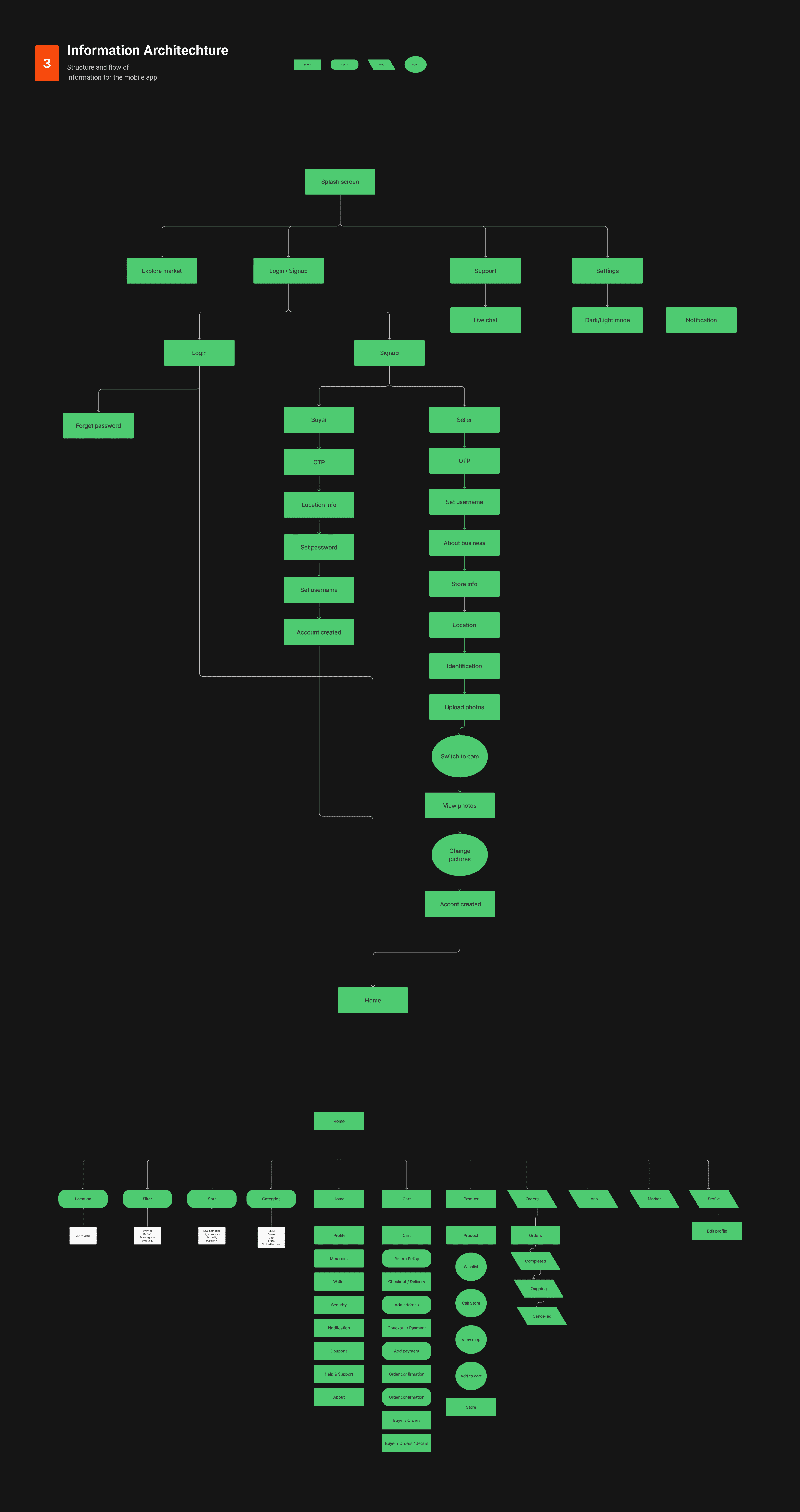

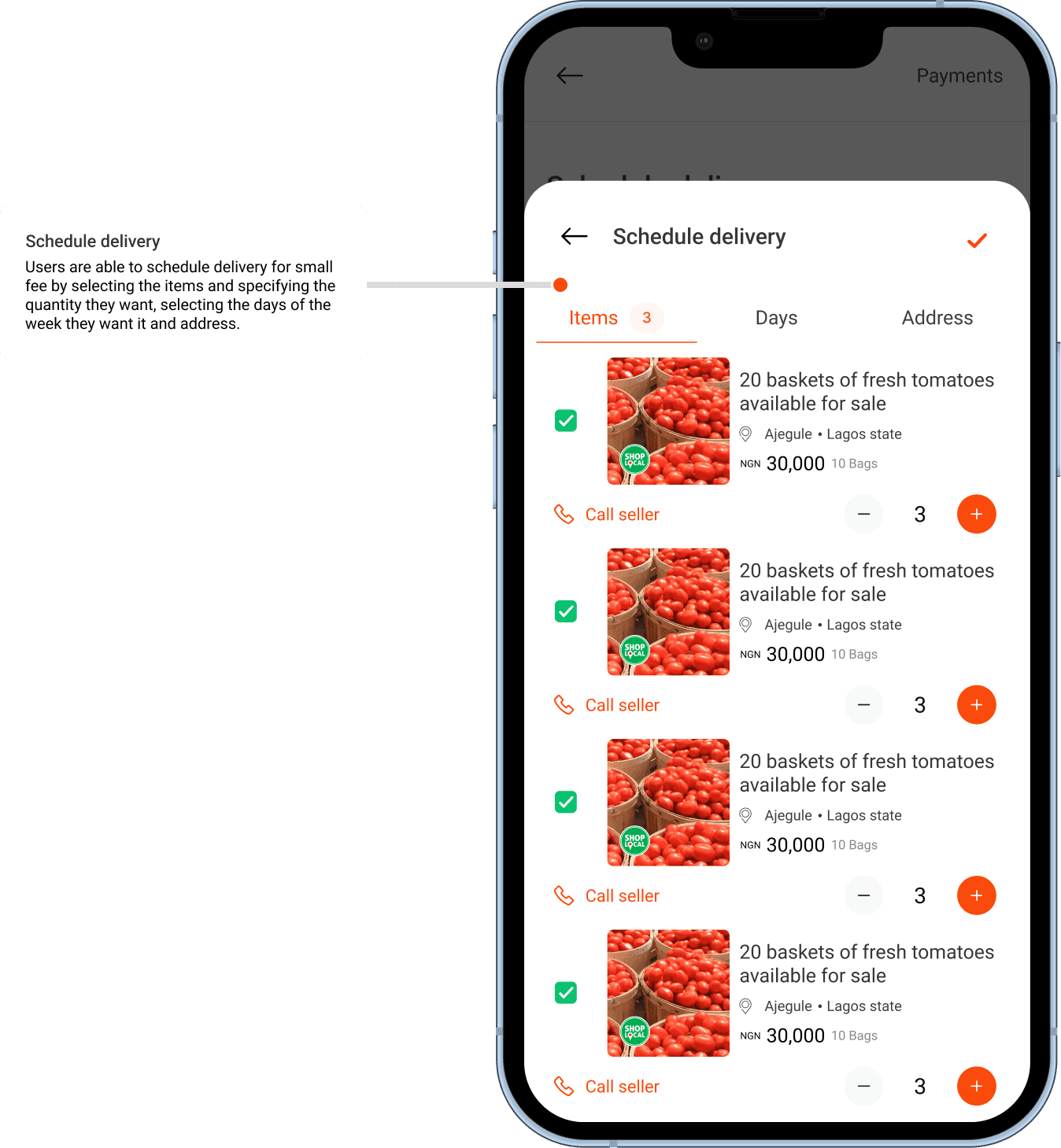

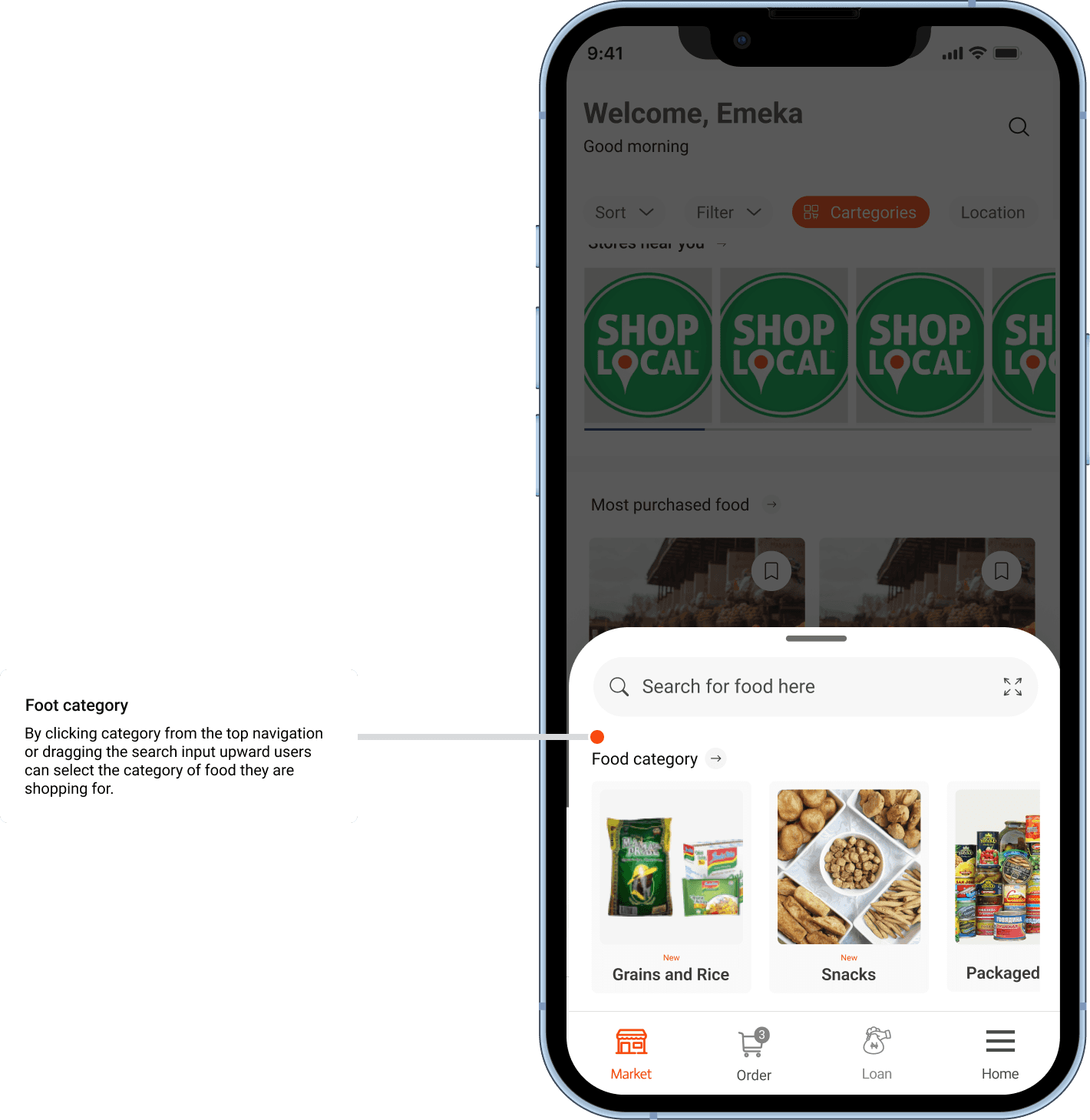

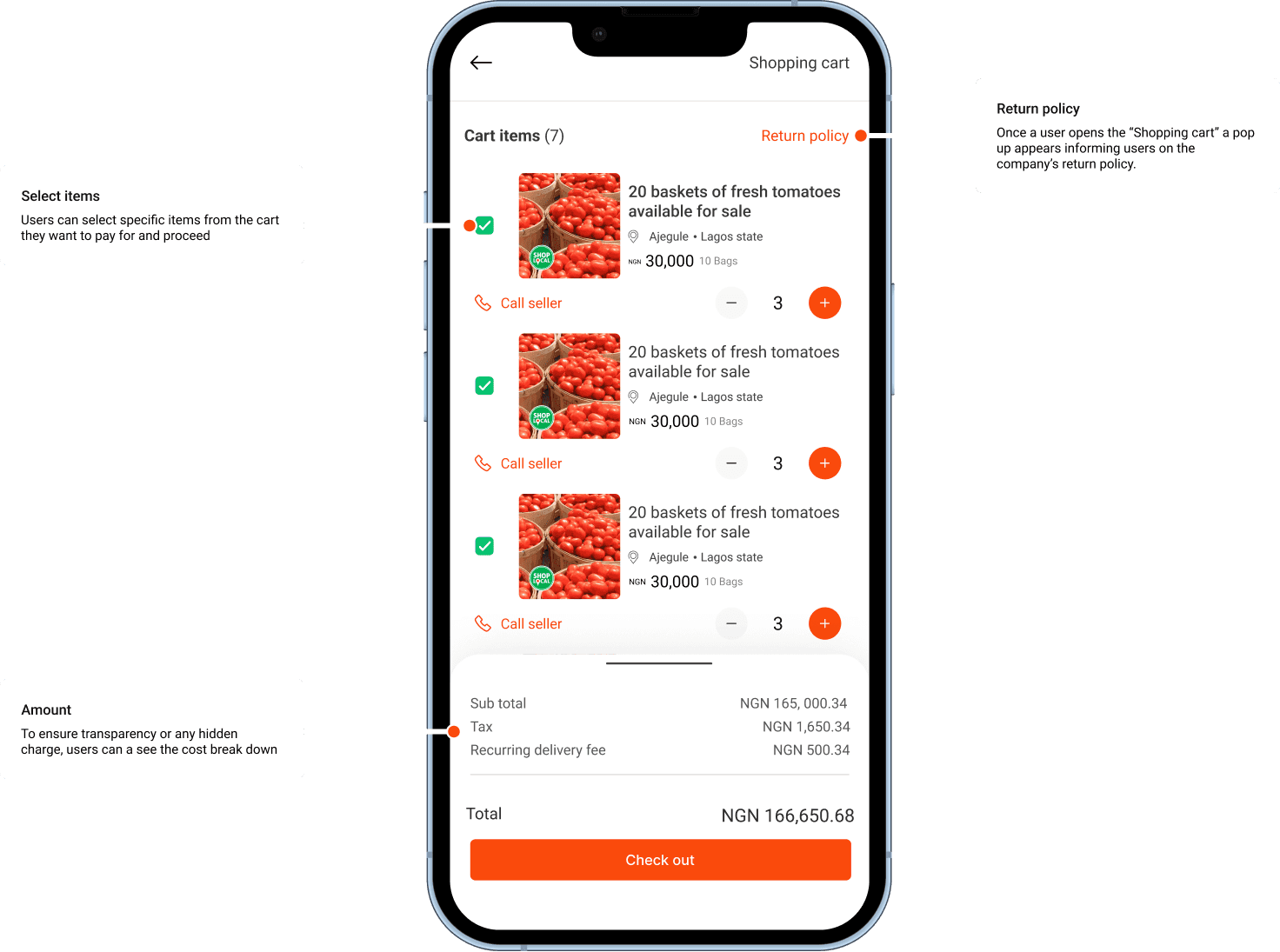





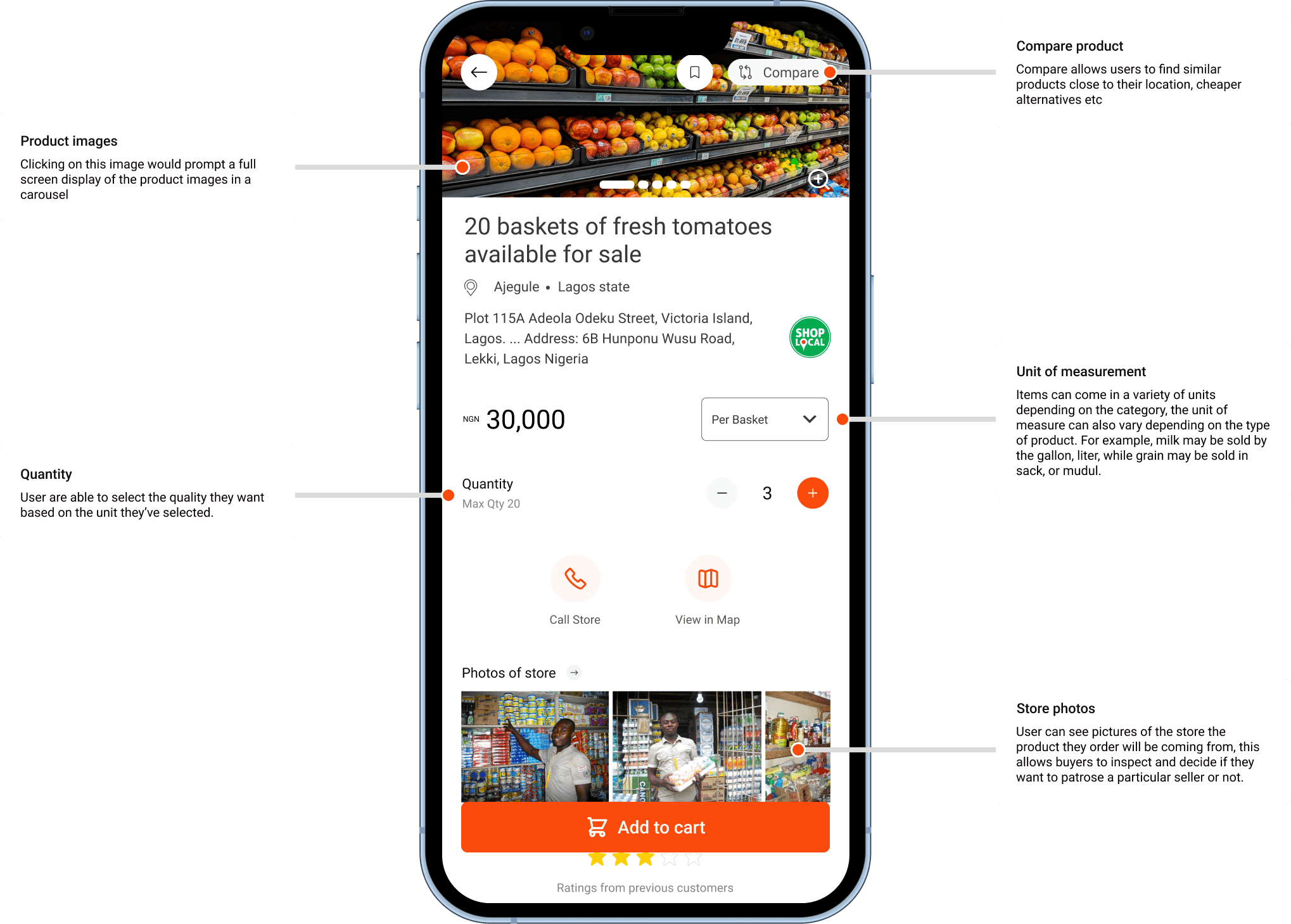





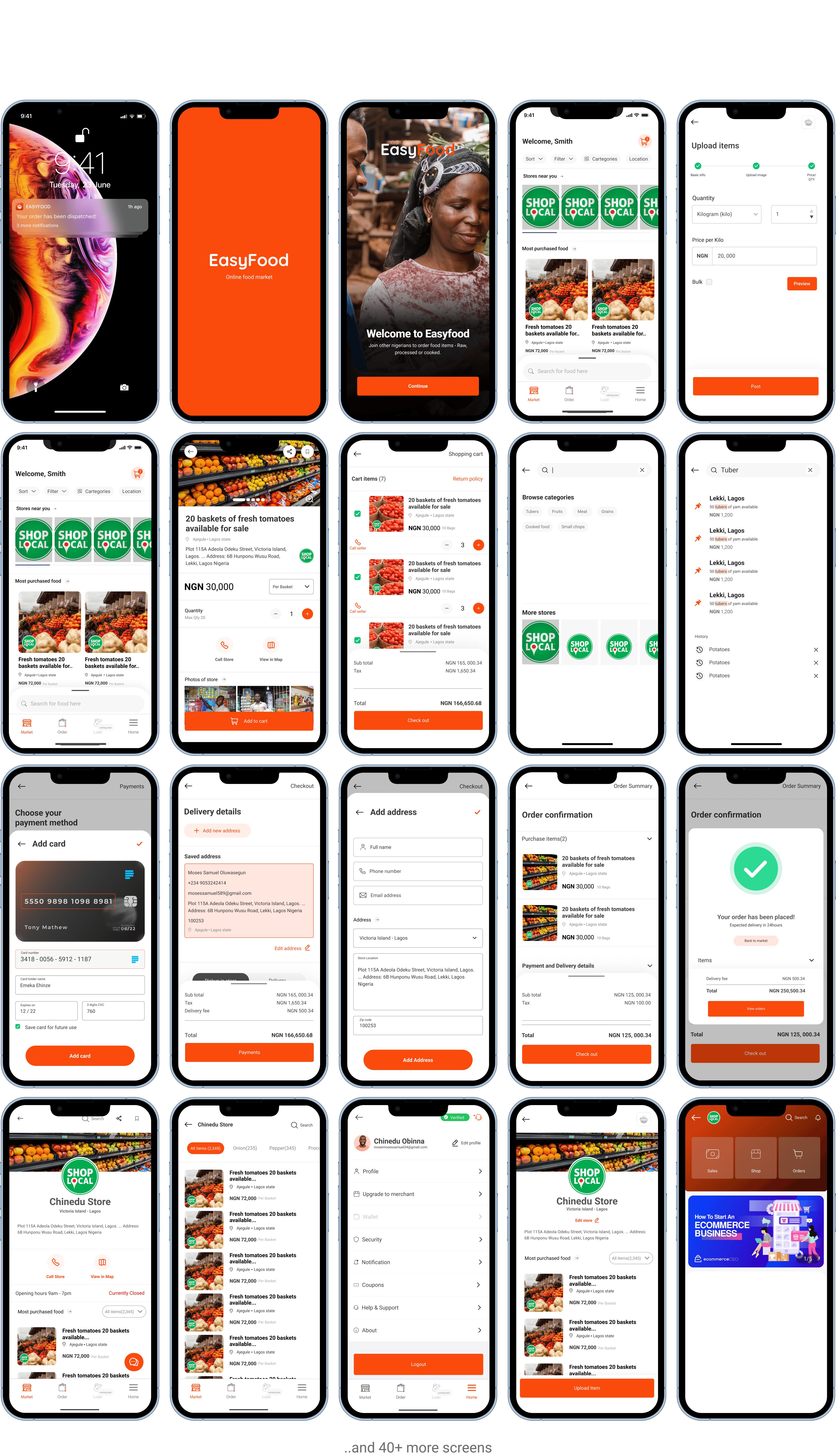


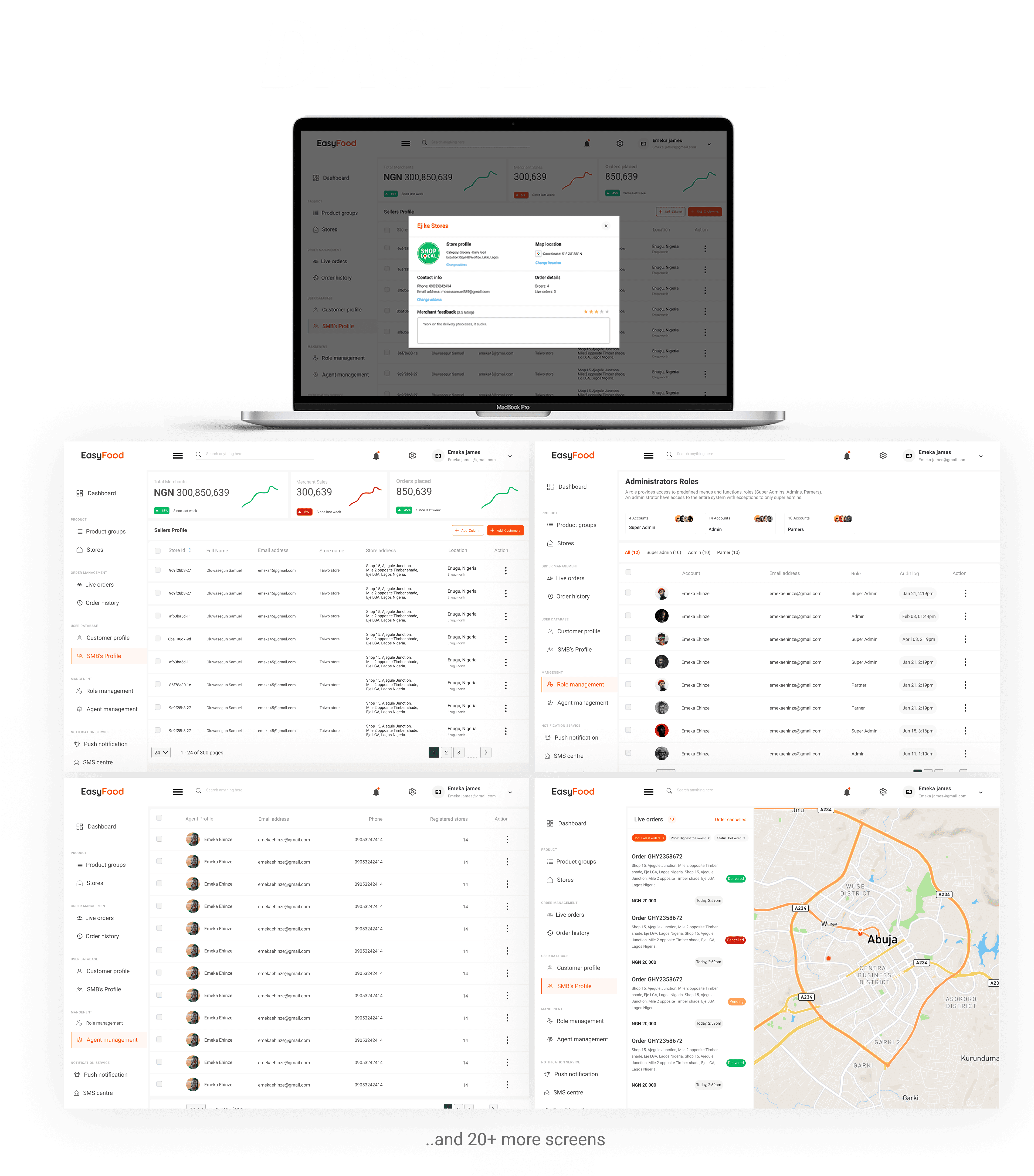

Throughout the design process, we gathered feedback and iterated on our solution to ensure that it is user-friendly and meets the needs of our target audience.
By providing a platform for buyers to easily browse and purchase food items and for sellers to manage their sales and reach a wider audience.
Throughout the design process, we gathered feedback and iterated on our solution to ensure that it is user-friendly and meets the needs of our target audience.
By providing a platform for buyers to easily browse and purchase food items and for sellers to manage their sales and reach a wider audience.
Up Next
Up Next
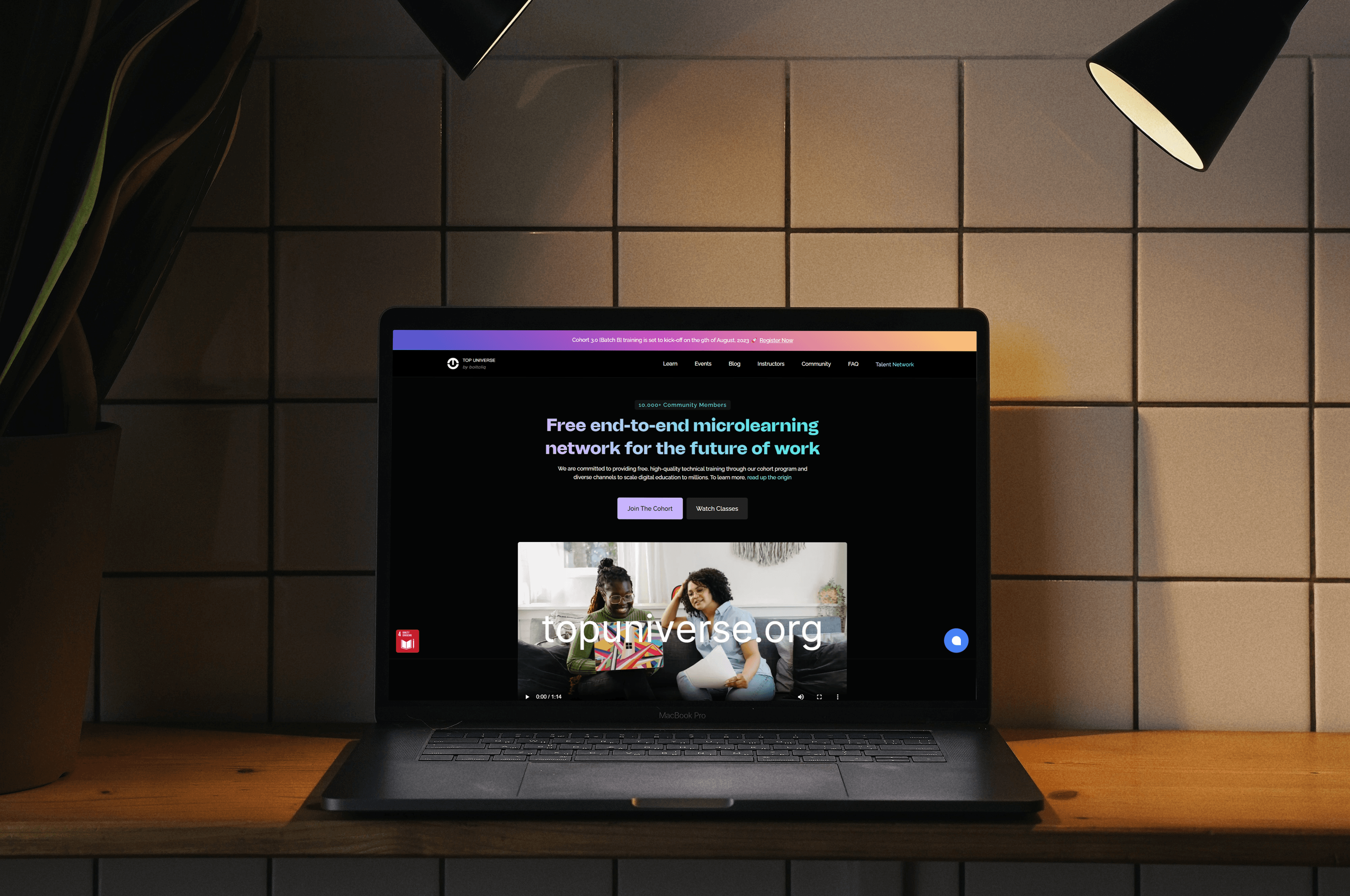
Open Project